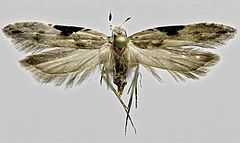Hypatima
| Hypatima | |
|---|---|
 | |
| Lobster-clawed Moth (Hypatima rhomboidella) specimen | |
| Scientific classification | |
| Kingdom: | Animalia |
| Phylum: | Arthropoda |
| Class: | Insecta |
| Order: | Lepidoptera |
| Division: | Ditrysia |
| Superfamily: | Gelechioidea |
| Family: | Gelechiidae |
| Subfamily: | Dichomeridinae (disputed) |
| Tribe: | Chelariini (but see text) |
| Genus: | Hypatima Hübner, 1825 |
| Type species | |
| Tinea conscriptella Hübner, 1805 | |
| Species | |
|
Dozens, see text | |
| Synonyms | |
|
Many, see text | |
Hypatima is a genus of the twirler moth family (Gelechiidae). Among these, it belongs to a distinct lineage, which is variously treated as tribe Chelariini in subfamilies Dichomeridinae (like done here), Gelechiinae, or even Pexicopiinae, and historically was considered a subfamily in its own right, Chelariinae. Of this lineage, Hypatima – under its junior synonym Chelaria – is the type genus. This genus has numerous species, but its exact limits are not quite clear (see below). This genus occurs mainly in the Southern Hemisphere, though one of the better-known species is the only member of this genus native to Europe, the Lobster-clawed Moth (H. rhomboidella).[1]
Selected species
Species of Hypatima include:
|
|
Taxonomy and systematics
The genus Hypatima was established by Jacob Hübner about 1825, though some authors mistakenly credited G.A.W. Herrich-Schäffer to have done it about 1853. Herrich-Schäffer, however, only cited the genus as established by Hübner. As regards Chelaria, this has been treated as distinct genus by several authors. But this was based on the mistaken assumption that its type species, "Chelaria conscripta", was a distinct taxon. However, it is merely an unjustified name-change of Hypatima conscriptella, and hence Hypatima and Chelaria are objective synonyms.[2]
A group within this genus is remarkably similar to Chelophoba melaina, an enigmatic species that is generally assigned to the twirler moth subfamily Pexicopiinae, though its exact relationships therein are obscure. As remarked above, the Chelariini have occasionally been allied with the Pexicopiinae. In any case, it is not impossible that this group might be better assigned to Chelophoba.[3]
Synonyms
Due to its somewhat convoluted taxonomic history, there are many junior synonyms or otherwise invalid scientific names for Hypatima moths. Some of these might theoretically apply as subgenus names, but this is not usually done pending a thorough review of the genus. The obsolete scientific names are:[4]
- Allocota Meyrick, 1904 (non Motschulsky, 1860: preoccupied)
- Allocotaniana Strand, 1913
- Cellaria (lapsus)
- Chelaria Haworth, 1828
- Cheleria (lapsus)
- Cymatomorpha Meyrick, 1904
- Deuteroptila Meyrick, 1904
- Episacta Turner, 1919
- Hypatina (lapsus)
- Semodictis Meyrick, 1909
- Stomylia Snellen, 1878
- Tituacia F.Walker, 1864
Footnotes
References
| Wikimedia Commons has media related to Hypatima. |
- Australian Biological Resources Study (ABRS) (2010): Australian Faunal Directory – Hypatima. Version of 2010-NOV-18. Retrieved 2011-OCT-17.
- Clarke, John Frederick Gates (1986): Pyralidae and Microlepidoptera of the Marquesas Archipelago. Smithsonian Contributions to Zoology 416: 1-485. PDF fulltext (214 MB!)
- Fauna Europaea (FE) (2011): Hypatima. Version 2.4, 2011-JAN-27. Retrieved 2011-OCT-17.
- Pitkin, Brian & Jenkins, Paul (2004a): Butterflies and Moths of the World, Generic Names and their Type-species – Chelaria. Version of 2004-NOV-05. Retrieved 2011-OCT-17.
- Pitkin, Brian & Jenkins, Paul (2004b): Butterflies and Moths of the World, Generic Names and their Type-species – Hypatima Hübner, 1825. Version of 2004-NOV-05. Retrieved 2011-OCT-17.
- Pitkin, Brian & Jenkins, Paul (2004c): Butterflies and Moths of the World, Generic Names and their Type-species – Hypatima Herrich-Schäffer, 1953 [sic]. Version of 2004-NOV-05. Retrieved 2011-OCT-17.